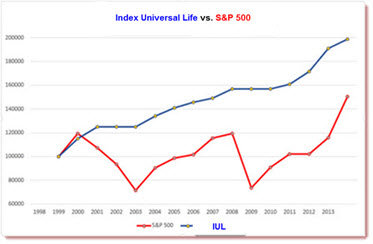
Our previous two Blog posts were on Term life insurance and Whole Life insurance. We wrote that insurance of all types are intended to transfer financial risk from you and your family to the deep pockets of an insurance company. The first question you should ask yourself in buying insurance coverage is; what am I insuring, for how long and why? Write that down as your guide when you research your insurance choices. you may find that Universal life insurance is the right choice for you.
Term insurance is designed for life insurance needs that are temporary, even if long-term like a mortgage or supporting children. Term life insurance transfers the financial risk of a premature death from your family to the insurance company. If you are fortunate enough to have purchased a Living Benefit Term life insurance policy, then the financial impact of many major medical events like cancer, heart attack, stroke, ALS is also transferred to the insurance company, in addition to the risk of premature death. It’s important to note that the number one cause of bankruptcy in the United States is the financial impact of major critical and chronic illness, even considering the expenses covered by health insurance. It is not a coincidence that the average age of a major medical event in the U.S. is 45, and the average age of bankruptcy is 46. This is why Living Benefit Life Insurance, with annual premiums no more than the old insurance, is so important. But I digress……
We also wrote that Whole Life, a permanent cash value insurance, adds another layer of insurance coverage in addition to the benefits of Term life insurance. Not only does the life insurance and living benefit last as long as you pay your premiums, but Whole Life insurance also transfers the financial risk of outliving your income from you, to the deep pockets of an insurance company. Whole Life has guaranteed returns on your investment that build a cash value. You can access that cash value tax-free at any time, for any reason. Thus, this is a tool often used by the wealthy to build a tax-free retirement income that supplements other retirement funds.
In the Blog post we are going to detail the benefits of another permanent, cash value insurance product called Universal Life, and show how it differs from Whole Life and offers greater potential protection from outliving your income. First, keep in mind that there are two types of Universal Life; a fixed Universal life and a Variable Universal Life. Variable Universal Life is a mutual fund product wrapped in an insurance blanket. Like any other mutual fund, the investment performance risk is born entirely by the consumer. This also can have an impact on the longevity / permanent structure of your insurance. The biggest difference between fixed Universal Life and Variable Universal Life is that with the fixed product the insurance company is bearing the investment performance risk, with the variable product, you bear the risk. Again, because the objective of insurance is to transfer the financial risk of unexpected events from you to an insurance company, we only recommend and will only discuss the fixed Universal Life policies.
Universal Life Insurance
Each Universal Life insurance policy has two parts; the first part is the cost of insurance. This is the cost of term insurance for the current year of the policy. The second part is the cash value. When you make a payment to your Universal Life policy, the amount you pay that is in excess to the term insurance cost is credited to your cash value. That cash value grows tax free and can be accessed at any time for any reason you choose.
There is one particular type of fixed Universal Life policy that has become the life insurance product most in demand in the United States; the Indexed Universal Life insurance policy.
With the indexed Universal Life policy, the cash value has two growth components; a minimum growth rate and a growth rate pegged to the positive years of an index. The most common index used is the S&P 500. There are other indexes available, but for the sake of brevity we will only use the S&P 500 equity index as an example. The Indexed Universal Life policy is in such demand that it accounts for 38% of the entire life insurance market in 2013.
Fixed Index Universal Life
With the Fixed Index Universal Life, the premiums paid that exceed the cost of term insurance are guaranteed to participate on the upside of the stock market and guaranteed not to lose value. In other words, when the stock market is up, your investment is up. When the stock market is down, your investment stays at its value. Different insurance companies offer different levels of index participation. Some will offer participation in the upside but not more than 8%, others offer much more.
Some important points:
· Most Fixed Index universal Life policies do not participate in 100% of the stock market gains in any given year. They will typically have a maximum percentage gain called a cap rate. If your cap rate is 8%, for example, if the stock market is up 8% you will get an 8% return. However if 8% is the maximum gain allowed, then when the stock market gains 10% your life insurance policy will still only gain 8%.
· The percentage gain with the stock market is not the most important feature of this type of life insurance. The most important feature is the combination of a percentage gain in equity growth plus the fact that the value never decreases. So, if the market is down by 5%, or 10% or even 50%, your money is safe and holds its value without decreasing. This is an extraordinarily powerful feature. The reason that equity markets (stock markets) have to have large upside years is that they have to overcome the negative years. If you have no negative years to overcome, your long-term growth can be substantial and without risk.
· Keep in mind, the performance and cap rate is contractually guaranteed to you, regardless of the actual performance of the insurance company’s portfolio. Because the funds of a fixed insurance policy are mixed with the general funds of the insurance company, the actual portfolio never takes pure stock market risk. The bottom line is that your policy is credited with the returns guaranteed to you. The insurance company bears the risk of the actual investment performance, not you. With a fixed Indexed Universal Life policy, you have transferred investment risk from you to the deep pockets of an insurance company.
Let’s look at the math for an example of the power of growth without negative years. Say you have $10,000 in the stock market and the market loses 50%, like it has done twice since the year 2000. Now your investment is worth just $5,000. What percent return do you need to just to get back to even?? If the market lost 50% in one year and then gained 50% the next years how much money would you have? If your investment lost 50%, you would need a gain of 100% just to break even. If your $10,000 lost 50% one year and gained 50% the next, you would have $7,500. You would still be down by 25% AND you will still need a 33.33% return just to break even.
Another way to look at it is this; if you have $10,000 in the stock market and it loses 50% the first year, then gains 10% each year for the next four years your stock market portfolio would not break even until during the fourth year of 10% gains. However, the indexed Universal Life policy with an 8% cap would not lose value when the market dropped 50%, it would simply give you a 0% return that year. Then, each year the market advanced by 10% you would be credited with an 8% gain. By the time the stock market portfolio got back to even, your Indexed Universal Life policy would be worth $13,605….and you would never have had to stomach a negative year.
Now that you understand the devastating impact negative performance years can have on your portfolio, you can better understand the power of a contractual guarantee that you will never lose money.
Take a look at the chart below. The blue line represents a fixed Index Universal Life product that can only participate in a portion of the stock market gains, but will hold its value when the stock market declines. Note that when the stock market (red line) declined, the insurance policy held its value. It took years for the stock market to get back to even. By then the value of the Index Universal Life policy was well ahead.
 The bottom line: If outliving your income is a concern, in most cases the fixed Indexed Universal Life insurance policy will be a better choice than a Whole Life policy. You will typically have the same guaranteed return rate, but the indexed feature of the Universal Life policy offers a higher potential return over long periods of time. You also have the flexibility of investing more into your Universal Life policy than the minimum required by the policy. In this way you can supplement your retirement or any long-term investment plan you have. You can also adjust payments (as long as you are making the minimum) based on your current budget. When the cash value is large enough to make your insurance payments for you, you have the flexibility of not paying into the policy for a period of time.
The bottom line: If outliving your income is a concern, in most cases the fixed Indexed Universal Life insurance policy will be a better choice than a Whole Life policy. You will typically have the same guaranteed return rate, but the indexed feature of the Universal Life policy offers a higher potential return over long periods of time. You also have the flexibility of investing more into your Universal Life policy than the minimum required by the policy. In this way you can supplement your retirement or any long-term investment plan you have. You can also adjust payments (as long as you are making the minimum) based on your current budget. When the cash value is large enough to make your insurance payments for you, you have the flexibility of not paying into the policy for a period of time.
When we look at the entire picture of insurance needs for a typical family, for most people that solution is a mixture of both term and cash value insurance. It would be a good idea to compare the pros and cons of fixed Indexed Universal Life vs. Whole Life insurance along with a detailed discussion of each with your insurance professional.
Last, but not least, there are fixed Indexed Universal Life insurance policies with Living Benefits. These policies vary in how they approach the living benefit issue, but expect that you will have access to the death benefit, or a portion of the death benefit, in the case of a serious medical event like cancer, heart attack, stroke, ALS and more. Or a serious chronic illness or a prolonged terminal illness. In this day and age, no matter what type of life insurance you are buying, you should expect and research its living benefits option.
Shield Insurance Solutions is independent. Our goal is to find the best insurance company and policy for you. We specialize in living benefit life insurance and work with nearly 100 different insurance companies in order to find the right policy at the right value for you. We are transparent and have been in the financial services industry since 1984. Our life products include Whole Life, Universal Life and Term Insurance, mortgage protection insurance and final expense insurance. As independent agents, we work hard to find the best life insurance company for you, with the best life insurance rates and value. We are based in Jupiter and Palm Beach Florida and licensed in almost every state. If you are shopping for a life insurance quote, we can show you what many of the top insurance companies will offer. The price differences will amaze you. Visit www.ShieldInsuranceSolutions.com to get a free life insurance quote comparison, or call us at (800) 847-9680.
